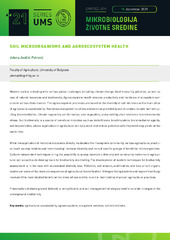Приказ основних података о документу
SOIL MICROORGANISMS AND AGROECOSYSTEM HEALTH
| dc.creator | Jovičić-Petrović, Jelena | |
| dc.date.accessioned | 2024-02-02T13:13:35Z | |
| dc.date.available | 2024-02-02T13:13:35Z | |
| dc.date.issued | 2021 | |
| dc.identifier.uri | http://aspace.agrif.bg.ac.rs/handle/123456789/6843 | |
| dc.description.abstract | Modern society is dealing with serious global challenges including climate change, food insecurity, pollution, as well as loss of natural resources and biodiversity. Agroecosystem health ensures the productivity and resilience of ecosystem services to various disturbances. The agroecosystem processes are based on the diversity of soil microbes as the main pillar of agricultural sustainability. Numerous ecosystem functions and services provided by soil microbes include nutrient cycling, bioremediation, climate regulation, soil formation, pest regulation, and providing plant resilience to environmental stress. Soil biodiversity is a source of beneficial microbes such as biofertilizers, biostimulators, bioremediation agents, and biopesticides, whose application in agriculture can help avoid and reduce pollution with improved crop yields at the same time. While the application of microbial inoculants directly modulates the rhizosphere community, various agricultural practices (such as crop rotation and intercropping) increase diversity and recruit specific groups of beneficial microorganisms. Culture-independent techniques bring the possibility to access taxonomic diversity and community networks in agricultural soil as well as to develop tools for biodiversity monitoring. The development of modern techniques for biodiversity assessment is in the race with accelerated diversity loss. Pollution, soil erosion, acidification, and loss of soil organic matter are some of the main consequences of agricultural intensification. Nitrogen-fixing bacteria and mycorrhizal fungi represent the most studied beneficial microbes whose activity in soil is restricted by improper agricultural practices. Preservation of above-ground diversity is not sufficient, and soil management strategies need to consider changes in the underground biodiversity. | sr |
| dc.language.iso | en | sr |
| dc.rights | openAccess | sr |
| dc.rights.uri | https://creativecommons.org/licenses/by/4.0/ | |
| dc.source | Simpozijum „Mikrobiologija životne sredine“, UMS Serija 2021, 16. decembra 2021, Book of abstracts 40.str. | sr |
| dc.subject | agricultural sustainability | sr |
| dc.subject | agroecosystem | sr |
| dc.subject | ecosystem services | sr |
| dc.subject | soil microbiome | sr |
| dc.title | SOIL MICROORGANISMS AND AGROECOSYSTEM HEALTH | sr |
| dc.type | lecture | sr |
| dc.rights.license | BY | sr |
| dc.description.other | Predavanje po pozivu | sr |
| dc.identifier.fulltext | http://aspace.agrif.bg.ac.rs/bitstream/id/26104/bitstream_26104.pdf | |
| dc.identifier.rcub | https://hdl.handle.net/21.15107/rcub_agrospace_6843 | |
| dc.type.version | publishedVersion | sr |


